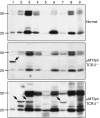Contribution of alphabeta and gammadelta T cells to the generation of primary immunoglobulin G-driven autoimmune response in immunoglobulin- mu-deficient/lpr mice
- PMID: 15147570
- PMCID: PMC1782487
- DOI: 10.1111/j.1365-2567.2004.01883.x
Contribution of alphabeta and gammadelta T cells to the generation of primary immunoglobulin G-driven autoimmune response in immunoglobulin- mu-deficient/lpr mice
Abstract
Class switch recombination (CSR) is a T-cell-dependent mechanism regulating isotype switching in activated mature B cells. Recently we showed that T-cell-independent CSRs occur spontaneously during B lymphopoiesis, but such cells are negatively selected by Fas signalling. In immunoglobulin mu-deficient mice, lack of Fas rescues isotype-switched B cells, resulting in generation of an autoimmune primary immunoglobulin G (IgG) repertoire in muMT/lpr mice. In the present study, we studied the role of alphabeta and gammadelta T cells in regulating this primary gammaH-driven repertoire. We found that a lack of alphabeta T cells significantly inhibited IgG production and autoimmunity in muMT/lpr mice, whereas a lack of gammadelta T cells resulted in augmented IgG production and autoimmunity. Also, a lack of T cells in muMT mice rescued isotype-switched B cells and serum IgG, probably owing to the lack of available FasL. We suggest that although CSRs in B-cell lymphopoiesis are T-cell independent, alphabeta T cells are important in the expansion of isotype-switched B-cell precursors and in promoting gammaH-driven autoimmunity, whereas gammadelta T cells regulate these cells.
Figures





Similar articles
-
Generation and selection of an IgG-driven autoimmune repertoire during B-lymphopoiesis in Igmicro-deficient/lpr mice.Int Immunol. 2004 Jul;16(7):905-13. doi: 10.1093/intimm/dxh092. Epub 2004 May 17. Int Immunol. 2004. PMID: 15148286
-
A fail-safe mechanism for negative selection of isotype-switched B cell precursors is regulated by the Fas/FasL pathway.J Exp Med. 2003 Nov 17;198(10):1609-19. doi: 10.1084/jem.20030357. J Exp Med. 2003. PMID: 14623914 Free PMC article.
-
Propagation and regulation of systemic autoimmunity by gammadelta T cells.J Immunol. 1996 Dec 15;157(12):5689-98. J Immunol. 1996. PMID: 8955223
-
Class switch recombination in B lymphopoiesis: a potential pathway for B cell autoimmunity.Autoimmun Rev. 2004 Aug;3(6):464-9. doi: 10.1016/j.autrev.2004.03.008. Autoimmun Rev. 2004. PMID: 15351312 Review.
-
Development and selection of gammadelta T cells.Immunol Rev. 2007 Feb;215:15-31. doi: 10.1111/j.1600-065X.2006.00478.x. Immunol Rev. 2007. PMID: 17291276 Review.
Cited by
-
Autoantibodies cause nociceptive sensitization in a mouse model of degenerative osteoarthritis.Pain. 2024 Dec 17;166(7):1519-1531. doi: 10.1097/j.pain.0000000000003500. Pain. 2024. PMID: 39835597
-
Spinal disk injury induces germinal center formation, pronociceptive antibody production, and chronic nociceptive sensitization in a male mouse back pain model.Pain. 2025 Jul 7:10.1097/j.pain.0000000000003706. doi: 10.1097/j.pain.0000000000003706. Online ahead of print. Pain. 2025. PMID: 40623266
References
-
- Rajewsky K. Clonal selection and learning in the antibody system. Nature. 1996;381:751–8. - PubMed
-
- Rolink AG, Schaniel C, Andersson J, Melchers F. Selection events operating at various stages in B cell development. Curr Opin Immunol. 2001;13:202–7. - PubMed
-
- Niiro H, Clark EA. Regulation of B-cell fate by antigen-receptor signals. Nat Rev Immunol. 2002;2:945–56. - PubMed
-
- Seagal J, Melamed D. Selection events in directing B cell development. Histol Histopathol. 2003;18:519–27. - PubMed
Publication types
MeSH terms
Substances
LinkOut - more resources
Full Text Sources
Molecular Biology Databases
Research Materials
Miscellaneous
